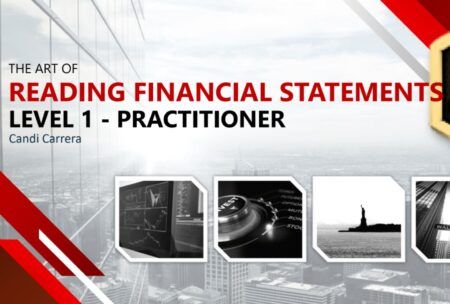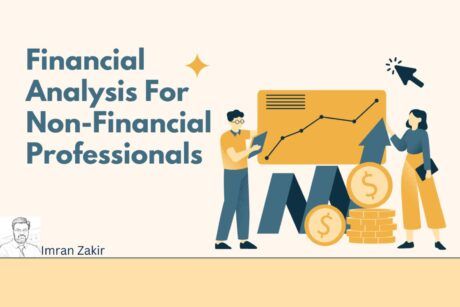Gain invaluable insights into financial statements from an experienced value investor. Take the course now and enhance your financial acumen. Enroll today! Read more.
My name is Candi Carrera. Born in 1972, I have been a value investor since 2001 with 90% of my personal savings invested in blue chip companies. One of my core principles is to never borrow money when investing in the stock market. I keep the remaining 10% as a permanent cash reserve to buy more stocks when markets get irrational & depressed which happens regularly. At the age of 50 and thanks to value investing learned from Warren Buffet & Benjamin Graham, I was able to "retire" and live tod
Access all courses in our library for only $9/month with All Access Pass
Get Started with All Access PassBuy Only This CourseAbout This Course
Who this course is for:
- Students in accounting and corporate finance
- Value investors
- People interested in corporate finance and financial statements
- Financial analysts
- Business appraisers
- Accountants
- Corporate Officers
- Anybody interested in analysing and investing into companies
What you’ll learn:
- Establish information source and download the latest financial report and identify accounting standard used IFRS, US GAAP or Local GAAP
- Understand and identify main corporate governance elements: Determine corporate governance 1- or 2-tier model and external regulation
- Understand role of statutory auditor, if audited identify statutory auditor, tenure of statutory auditor and audit opinion
- Understand the scope of consolidation (and unconsolidation) of the company
- Be able to do a vertical analysis of the balance sheet and understand material assets and liabilities in balance sheet
- Identify sources of capital including long-term debt, related schedule, cost to service long-term debt including interest coverage ratio, equity capital source
- Deepen understanding of value creation for shareholders by understanding ROIC and WACC
- Understand profitability of company by analysing revenue segments and cash generating assets, understand operating cash flow and working capital vs other cash flows
- Be able to read earnings information including EPS, NOPAT, EBITDA, EBIT and net income
Requirements:
- Be interested in companies
- Have a minimal knowledge of how companies and businesses in general work
- Desire to learn how to read financial statements
Financial statements appear complex and long, their reading requires judgment and practice. People do not know where to start reading and what to look for or people read financial statements in a linear/sequential way without being able to grasp the main elements, even red flags related to the company. This course intends to teach you the main reading keys to read, understand and digest financial statements and financial reports.
As Warren Buffett stated, “You have to understand accounting and you have to understand the nuances of accounting. It’s the language of business and it’s an imperfect language, but unless you are willing to put in the effort to learn accounting – how to read and interpret financial statements – you really shouldn’t select stocks yourself”
I took the approach of writing this course by looking back on what I was missing from my teachers and professors in my accounting and corporate finance classes. This course uses a different approach in reading financial statements and being able to quickly grasp the essence of the company being analysed.
After taking the course, you will be able to:
- Identify and understand accounting standard used IFRS, US GAAP or Local GAAP
- Differentiate between 3 main types of financial statements (balance sheet, cash flow and income statement)
- Understand the fundamental accounting principles like going concern, fair valuation, principle of prudence, accrual vs cash accounting, etc.
- Understand and identify main corporate governance elements including corporate governance 1- or 2-tier models, role of shareholders and board of directors
- Understand role of statutory auditor, being able to identify if a report is audited or unaudited; if audited, identify who the statutory auditor is, tenure of statutory auditor, comments about statutory auditor’s independence/conflict of interest/related fees and audit opinion
- Understand the scope of consolidation (and unconsolidation) of the reporting company and the 4 methods how subsidiaries can be (or not) consolidated into financial statements
- Be able to do a vertical analysis of the balance sheet and understand main profit generating assets and also the sources of capital in the balance sheet
- Identify sources of capital including long-term debt and its related schedule, cost to service long-term debt including interest coverage ratio, equity capital source including potential retained earnings
- Deepen understanding of value creation for shareholders by understanding ROIC and WACC
- Understand profitability of company by analysing revenue segments (if available) and cash generating assets, understand operating cash flow and working capital vs financing and investing cash flows
- Be able to read earnings information including EPS, NOPAT, EBITDA, EBIT and net income
The course also contains many practical examples as in all of my courses. We will practice and discuss financials of companies like Kelloggs, Mercedes, Telefonica, 3M, Evergrande, Alphabet, Meta, Microsoft, Unilever, Wells Fargo, Wirecard, CostCo and many more.
At the end of the training, I will show you the complete process on how I read the financial statements for 3 companies (Vonovia, Qurate, Skywest Airlines) so that you can exactly see and hopefully replicate how I grasp the essence of companies that are not known to me at the beginning.
Last but not least, adult education without practice, knowledge checks and assignments is only entertainment. For that specific reason the course contains 10+ assignments to practice yourself as homework.
Wishing you a lot of success taking this training and hoping it will make you grow as an investor, analyst or corporate professional. Thanking you as well again for selecting my course.
Our Promise to You
By the end of this course, you will have learned how to read financial statements.
10 Day Money Back Guarantee. If you are unsatisfied for any reason, simply contact us and we’ll give you a full refund. No questions asked.
Get started today!
Course Curriculum
| Section 1 - Introduction | |||
| Introduction | 00:00:00 | ||
| History And Purpose | 00:00:00 | ||
| Reporting Standards | 00:00:00 | ||
| Financial Statement Types | 00:00:00 | ||
| Reporting And Accounting Principles | 00:00:00 | ||
| Section 2 - Main Elements Of Corporate Governance | |||
| Corporate Law And Company Consolidation | 00:00:00 | ||
| Shareholders | 00:00:00 | ||
| Board Of Directors | 00:00:00 | ||
| Auditors | 00:00:00 | ||
| Section 3 - Inventory Of Company Resources And Capital | |||
| Balance Sheet Structure And Value Creation Cycle | 00:00:00 | ||
| Vertical And Horizontal Analysis – How To Capture Essence Of Balance Sheet | 00:00:00 | ||
| Primary Sources Of Capital – Equity | 00:00:00 | ||
| Secondary Source Of Capital – Introduction To Debt And Financial Debt | 00:00:00 | ||
| Other Types Of Debt And Liabilities | 00:00:00 | ||
| Introduction To Assets In Balance Sheet | 00:00:00 | ||
| Main Current Assets In Balance Sheet | 00:00:00 | ||
| Main Non-Current Or Long-Term Assets In Balance Sheet | 00:00:00 | ||
| Section 4 - Understanding Value Creation And Profitability | |||
| Revenues And Net Income | 00:00:00 | ||
| Net Income And Cash Flows | 00:00:00 | ||
| Realized Vs Unrealized Earnings | 00:00:00 | ||
| Value Creation And ROIC | 00:00:00 | ||
| Section 5 - Conclusion | |||
| Example 1 : Analysis Of Vonovia | 00:00:00 | ||
| Example 2 : Analysis Of Qurate | 00:00:00 | ||
| Example 3 : Analysis Of Skywest Airlines | 00:00:00 | ||
| Final Thoughts | 00:00:00 | ||
About This Course
Who this course is for:
- Students in accounting and corporate finance
- Value investors
- People interested in corporate finance and financial statements
- Financial analysts
- Business appraisers
- Accountants
- Corporate Officers
- Anybody interested in analysing and investing into companies
What you’ll learn:
- Establish information source and download the latest financial report and identify accounting standard used IFRS, US GAAP or Local GAAP
- Understand and identify main corporate governance elements: Determine corporate governance 1- or 2-tier model and external regulation
- Understand role of statutory auditor, if audited identify statutory auditor, tenure of statutory auditor and audit opinion
- Understand the scope of consolidation (and unconsolidation) of the company
- Be able to do a vertical analysis of the balance sheet and understand material assets and liabilities in balance sheet
- Identify sources of capital including long-term debt, related schedule, cost to service long-term debt including interest coverage ratio, equity capital source
- Deepen understanding of value creation for shareholders by understanding ROIC and WACC
- Understand profitability of company by analysing revenue segments and cash generating assets, understand operating cash flow and working capital vs other cash flows
- Be able to read earnings information including EPS, NOPAT, EBITDA, EBIT and net income
Requirements:
- Be interested in companies
- Have a minimal knowledge of how companies and businesses in general work
- Desire to learn how to read financial statements
Financial statements appear complex and long, their reading requires judgment and practice. People do not know where to start reading and what to look for or people read financial statements in a linear/sequential way without being able to grasp the main elements, even red flags related to the company. This course intends to teach you the main reading keys to read, understand and digest financial statements and financial reports.
As Warren Buffett stated, “You have to understand accounting and you have to understand the nuances of accounting. It’s the language of business and it’s an imperfect language, but unless you are willing to put in the effort to learn accounting – how to read and interpret financial statements – you really shouldn’t select stocks yourself”
I took the approach of writing this course by looking back on what I was missing from my teachers and professors in my accounting and corporate finance classes. This course uses a different approach in reading financial statements and being able to quickly grasp the essence of the company being analysed.
After taking the course, you will be able to:
- Identify and understand accounting standard used IFRS, US GAAP or Local GAAP
- Differentiate between 3 main types of financial statements (balance sheet, cash flow and income statement)
- Understand the fundamental accounting principles like going concern, fair valuation, principle of prudence, accrual vs cash accounting, etc.
- Understand and identify main corporate governance elements including corporate governance 1- or 2-tier models, role of shareholders and board of directors
- Understand role of statutory auditor, being able to identify if a report is audited or unaudited; if audited, identify who the statutory auditor is, tenure of statutory auditor, comments about statutory auditor’s independence/conflict of interest/related fees and audit opinion
- Understand the scope of consolidation (and unconsolidation) of the reporting company and the 4 methods how subsidiaries can be (or not) consolidated into financial statements
- Be able to do a vertical analysis of the balance sheet and understand main profit generating assets and also the sources of capital in the balance sheet
- Identify sources of capital including long-term debt and its related schedule, cost to service long-term debt including interest coverage ratio, equity capital source including potential retained earnings
- Deepen understanding of value creation for shareholders by understanding ROIC and WACC
- Understand profitability of company by analysing revenue segments (if available) and cash generating assets, understand operating cash flow and working capital vs financing and investing cash flows
- Be able to read earnings information including EPS, NOPAT, EBITDA, EBIT and net income
The course also contains many practical examples as in all of my courses. We will practice and discuss financials of companies like Kelloggs, Mercedes, Telefonica, 3M, Evergrande, Alphabet, Meta, Microsoft, Unilever, Wells Fargo, Wirecard, CostCo and many more.
At the end of the training, I will show you the complete process on how I read the financial statements for 3 companies (Vonovia, Qurate, Skywest Airlines) so that you can exactly see and hopefully replicate how I grasp the essence of companies that are not known to me at the beginning.
Last but not least, adult education without practice, knowledge checks and assignments is only entertainment. For that specific reason the course contains 10+ assignments to practice yourself as homework.
Wishing you a lot of success taking this training and hoping it will make you grow as an investor, analyst or corporate professional. Thanking you as well again for selecting my course.
Our Promise to You
By the end of this course, you will have learned how to read financial statements.
10 Day Money Back Guarantee. If you are unsatisfied for any reason, simply contact us and we’ll give you a full refund. No questions asked.
Get started today!
Course Curriculum
| Section 1 - Introduction | |||
| Introduction | 00:00:00 | ||
| History And Purpose | 00:00:00 | ||
| Reporting Standards | 00:00:00 | ||
| Financial Statement Types | 00:00:00 | ||
| Reporting And Accounting Principles | 00:00:00 | ||
| Section 2 - Main Elements Of Corporate Governance | |||
| Corporate Law And Company Consolidation | 00:00:00 | ||
| Shareholders | 00:00:00 | ||
| Board Of Directors | 00:00:00 | ||
| Auditors | 00:00:00 | ||
| Section 3 - Inventory Of Company Resources And Capital | |||
| Balance Sheet Structure And Value Creation Cycle | 00:00:00 | ||
| Vertical And Horizontal Analysis – How To Capture Essence Of Balance Sheet | 00:00:00 | ||
| Primary Sources Of Capital – Equity | 00:00:00 | ||
| Secondary Source Of Capital – Introduction To Debt And Financial Debt | 00:00:00 | ||
| Other Types Of Debt And Liabilities | 00:00:00 | ||
| Introduction To Assets In Balance Sheet | 00:00:00 | ||
| Main Current Assets In Balance Sheet | 00:00:00 | ||
| Main Non-Current Or Long-Term Assets In Balance Sheet | 00:00:00 | ||
| Section 4 - Understanding Value Creation And Profitability | |||
| Revenues And Net Income | 00:00:00 | ||
| Net Income And Cash Flows | 00:00:00 | ||
| Realized Vs Unrealized Earnings | 00:00:00 | ||
| Value Creation And ROIC | 00:00:00 | ||
| Section 5 - Conclusion | |||
| Example 1 : Analysis Of Vonovia | 00:00:00 | ||
| Example 2 : Analysis Of Qurate | 00:00:00 | ||
| Example 3 : Analysis Of Skywest Airlines | 00:00:00 | ||
| Final Thoughts | 00:00:00 | ||



